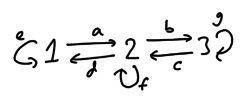Difference between revisions of "M(8,5,2)"
(Created page with "{{blockbox |title = M(8,5,2) - <math>B_0(k(A_5 \times C_2))</math> |image = M(8,5,2)quiver.png |representative = <math>B_0(k(A_5 \times C_2))</math> |defect = C2xC2xC2|<ma...") |
m |
||
| (3 intermediate revisions by the same user not shown) | |||
| Line 29: | Line 29: | ||
\end{array}\right)</math> | \end{array}\right)</math> | ||
|O-morita-frob = 1 | |O-morita-frob = 1 | ||
| − | |Pic-O = | + | |Pic-O = <math>C_2 \times C_2</math><ref><math>{\rm Pic}_{\mathcal{O}}(B_0(\mathcal{O}(C_2 \times A_5)))=\mathcal{L}(B_0(\mathcal{O}(C_2 \times A_5)))=\mathcal{L}(\mathcal{O}C_2) \times \mathcal{T}(B_0(\mathcal{O}A_5))</math> by [[References|[EL18c]]], giving the isomorphism type of <math>{\rm Pic}_\mathcal{O}(B)</math> in general.</ref> |
| + | |PIgroup = <math>S_4 \times C_2 \times C_2</math><ref>By Theorem 3.7 of [[References|[EL18c]]].</ref> | ||
|source? = No | |source? = No | ||
| − | |sourcereps = | + | |sourcereps = |
|k-derived-known? = Yes | |k-derived-known? = Yes | ||
|k-derived = [[M(8,5,2)]] | |k-derived = [[M(8,5,2)]] | ||
| Line 37: | Line 38: | ||
|coveringblocks = | |coveringblocks = | ||
|coveredblocks = | |coveredblocks = | ||
| + | |pcoveringblocks = | ||
}} | }} | ||
| Line 45: | Line 47: | ||
'''Quiver:''' a:<1,2>, b:<2,3>, c:<3,2>, d:<2,1>, e:<1,1>, f: <2,2>, g:<3,3> | '''Quiver:''' a:<1,2>, b:<2,3>, c:<3,2>, d:<2,1>, e:<1,1>, f: <2,2>, g:<3,3> | ||
| − | '''Relations w.r.t. <math>k</math>:''' ad=cb=0, bcda=dabc, e^2=f^2=g^2=0, af=ea, bg=fb, cf=gc, de=fd | + | '''Relations w.r.t. <math>k</math>:''' <math>ad=cb=0</math>, <math>bcda=dabc</math>, <math>e^2=f^2=g^2=0</math>, <math>af=ea</math>, <math>bg=fb</math>, <math>cf=gc</math>, <math>de=fd</math> |
== Other notatable representatives == | == Other notatable representatives == | ||
Latest revision as of 21:49, 5 December 2018
| Representative: | [math]B_0(k(A_5 \times C_2))[/math] |
|---|---|
| Defect groups: | [math]C_2 \times C_2 \times C_2[/math] |
| Inertial quotients: | [math]C_3[/math] |
| [math]k(B)=[/math] | 8 |
| [math]l(B)=[/math] | 3 |
| [math]{\rm mf}_k(B)=[/math] | 1 |
| [math]{\rm Pic}_k(B)=[/math] | |
| Cartan matrix: | [math]\left( \begin{array}{ccc} 8 & 4 & 4 \\ 4 & 4 & 2 \\ 4 & 2 & 4 \\ \end{array} \right)[/math] |
| Defect group Morita invariant? | Yes |
| Inertial quotient Morita invariant? | Yes |
| [math]\mathcal{O}[/math]-Morita classes known? | Yes |
| [math]\mathcal{O}[/math]-Morita classes: | [math]B_0(\mathcal{O} (A_5 \times C_2))[/math] |
| Decomposition matrices: | [math]\left( \begin{array}{ccc} 1 & 0 & 0 \\ 1 & 0 & 0 \\ 1 & 1 & 0 \\ 1 & 1 & 0 \\ 1 & 0 & 1 \\ 1 & 0 & 1 \\ 1 & 1 & 1 \\ 1 & 1 & 1 \\ \end{array}\right)[/math] |
| [math]{\rm mf}_\mathcal{O}(B)=[/math] | 1 |
| [math]{\rm Pic}_{\mathcal{O}}(B)=[/math] | [math]C_2 \times C_2[/math][1] |
| [math]PI(B)=[/math] | [math]S_4 \times C_2 \times C_2[/math][2] |
| Source algebras known? | No |
| Source algebra reps: | |
| [math]k[/math]-derived equiv. classes known? | Yes |
| [math]k[/math]-derived equivalent to: | M(8,5,2) |
| [math]\mathcal{O}[/math]-derived equiv. classes known? | Yes |
| [math]p'[/math]-index covering blocks: | |
| [math]p'[/math]-index covered blocks: | |
| Index [math]p[/math] covering blocks: |
Contents
Basic algebra
Quiver: a:<1,2>, b:<2,3>, c:<3,2>, d:<2,1>, e:<1,1>, f: <2,2>, g:<3,3>
Relations w.r.t. [math]k[/math]: [math]ad=cb=0[/math], [math]bcda=dabc[/math], [math]e^2=f^2=g^2=0[/math], [math]af=ea[/math], [math]bg=fb[/math], [math]cf=gc[/math], [math]de=fd[/math]
Other notatable representatives
Covering blocks and covered blocks
Projective indecomposable modules
Labelling the simple [math]B[/math]-modules by [math]S_1, S_2, S_3[/math], the projective indecomposable modules have Loewy structure as follows:
[math]\begin{array}{ccc} \begin{array}{c} S_1 \\ S_1 S_2 S_3 \\ S_2 S_3 S_1 S_1 \\ S_1 S_1 S_3 S_2 \\ S_3 S_2 S_1 \\ S_1 \\ \end{array}, & \begin{array}{c} S_2 \\ S_2 S_1 \\ S_1 S_3 \\ S_3 S_1 \\ S_1 S_2 \\ S_2 \\ \end{array}, & \begin{array}{c} S_3 \\ S_2 S_1 \\ S_1 S_2 \\ S_3 S_1 \\ S_1 S_3 \\ S_3 \end{array} \end{array} [/math]
Irreducible characters
All irreducible characters have height zero.
Back to [math]C_2 \times C_2 \times C_2[/math]- ↑ [math]{\rm Pic}_{\mathcal{O}}(B_0(\mathcal{O}(C_2 \times A_5)))=\mathcal{L}(B_0(\mathcal{O}(C_2 \times A_5)))=\mathcal{L}(\mathcal{O}C_2) \times \mathcal{T}(B_0(\mathcal{O}A_5))[/math] by [EL18c], giving the isomorphism type of [math]{\rm Pic}_\mathcal{O}(B)[/math] in general.
- ↑ By Theorem 3.7 of [EL18c].
